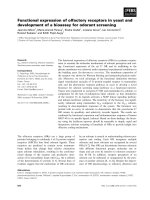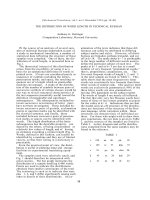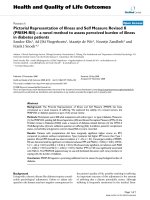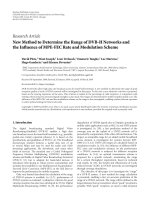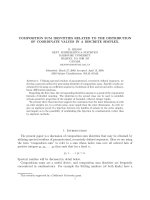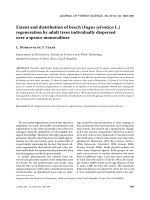DISTRIBUTION OF WAVE LOADS FOR DESIGN OF CROWN WALLS IN DEEP AND SHALLOW WATER
Bạn đang xem bản rút gọn của tài liệu. Xem và tải ngay bản đầy đủ của tài liệu tại đây (688.53 KB, 13 trang )
DISTRIBUTION OF WAVE LOADS FOR DESIGN OF CROWN WALLS IN DEEP
AND SHALLOW WATER
Jørgen Quvang Harck Nørgaard1, Thomas Lykke Andersen1
This paper puts forward a new method to determine horizontal wave loads on rubble mound breakwater crown walls
with specific exceedance probabilities based on the formulae by Nørgaard et al. (2013) as well as presents a new
modified version of the wave run-up formula by Van der Meer & Stam (1992). Predictions from the method are
compared to measured horizontal wave loads from scaled model tests, and the new method provides results which are
in agreement with measured values as long as the wave loads on the crown wall are relatively impulsive. Another aim
of the paper has been to compare the displacements of a crown wall exposed to wave loads with different exceedance
probabilities in an overload situation (in this case the loads exceeded by 0.1 % and 1/250 of the incident waves). The
comparison is made using the assumption that the Eigenfrequency of the crown wall and breakwater is significantly
higher than the dynamic wave load impulses on the structure. The relatively small difference in the evaluated
exceedance probabilities has a significant influence on the displacement of the monolithic structure. Therefore,
probabilistic design tools are recommended. Tools from the present paper will be used in future studies in more
detailed investigations on the influence from the load exceedance probability on the stability of crown walls.
Keywords: rubble mound breakwater; crown wall; sliding; physical modeling; design wave load
INTRODUCTION
Monolithic concrete crown walls are installed on rubble mound breakwater crests to reduce wave
overtopping and to provide access roads and installations on the crests. Various failure modes are
typically considered when ensuring the stability of these superstructures, such as the stability against
sliding, stability against rocking/tilting, and stability against geotechnical slip failure. However, for
crown walls Nørgaard et al. (2012) concluded that if the crown wall is able to move freely on the
rubble mound core material (without any passive pressure from the core material or filter material) and
if the internal strength of the crown wall is sufficient to avoid failure (failure mode a in Fig. 1), the
most important failure mode is horizontal sliding (failure mode b in Fig. 1). Predictions on
simultaneous horizontal and vertical wave loads are needed to design for this failure mode.
Crown walls are typically designed to remain stable in the design sea state. However, Nørgaard et
al. (2012) suggested allowing for small horizontal displacements of the superstructures in an overload
situation (failure mode b) in order to reduce structure costs. Additionally, instead of upgrading existing
rubble mound breakwater crown walls exposed to increasing wave loading due to climate changes,
small displacements can e.g. be accepted. However, the present paper demonstrates that such
displacements are a very non-linear function of the design wave height and that probabilistic design is
needed.
Figure 1. Typical failure modes of monolithic crown walls.
The horizontal wave load evolution on a monolithic structure during a wave run-up event
originates from dynamic loadings and reflective loadings, cf. Martin et al. (1999). The dynamic peak is
typically the highest with very short duration and appears due to a fast change in the direction of the
run-up bore when the wave hits the structure. The reflective loading comes shortly after the dynamic
loading and appears due to the water mass in the run-up bore rushing down the wall after the wave hits
the structure. The sizes of the peaks are closely related to the wave steepness and the ratio between the
parts of the wall which are protected and un-protected by the armour units.
Nørgaard et al. (2013) presented formulae for prediction of the horizontal dynamic wave loads
with low-exceedance probabilities in deep and shallow water wave conditions. The formulae were
updated versions of the Pedersen (1996) formulae, which are only valid for deep-water wave
conditions. More specifically, Nørgaard et al. (2013) provided predictions for FH,0.1%, MH,0.1%, and
Pb,0.1%, which are the horizontal wave load, overturning moment, and the front base pressure
respectively (see e.g. Fig. 5c) exceeded by 0.1 % of the incident waves. The prediction formulae by
1
Department of Civil Engineering, Aalborg University, Denmark, ,
1
2
COASTAL ENGINEERING 2014
Nørgaard et al. (2013) are based on H0.1% (i.e. the wave height exceeded by 0.1 % of the incident
waves).
Instead of the 0.1 % exceedance level in the formulae by Nørgaard et al. (2013), other design
formulae are based on exceedance levels defined by the average of the 1/250 highest waves, such as by
Cuomo et al. (2010) for prediction of wave loads on vertical breakwaters. Additionally, Goda (2010)
recommended using Hmax = 1.80H1/3 (approximately corresponding to H1/250 in Rayleigh distributed
waves) for prediction of design wave loads for vertical breakwaters, where H1/3 is the significant wave
height in the time domain. However, Goda (2010) noted the possibility for obtaining one or two wave
heights exceeding Hmax = 1.80H1/3 during a design storm, but argued that the influence from these
exceeding wave heights on the resulting sliding distance of a vertical breakwater would be small due to
the highly impulsive nature of these low-exceedance loads. This argument is questioned for crown
walls as the load is a very non-linear function of the wave height.
Objectives in Present Paper
So far, no studies have evaluated the statistical distribution of wave loads on crown walls in deep
and shallow water wave conditions. Additionally, no studies have investigated the sensibility of the
crown wall stability to the exceedance probability of the design wave load.
This paper has two main objectives. The first objective is to provide a simple tool which can
describe the statistical distribution of wave loads on crown walls and which can be used to predict
loads with other exceedance probabilities than e.g. FH,0.1% predicted by using the design formulae by
Nørgaard et al. (2013). Data from 2D small-scale laboratory tests, described in Nørgaard et al. (2013),
is used for the verification of the tool.
The second objective is to perform an initial evaluation on the influence from wave loads
exceedance probability on the sliding stability of crown walls. A simplified one-dimensional approach
described in Burcharth et al. (2008) and Nørgaard et al. (2012) is used for this analysis, together with
the model test data by Nørgaard et al. (2012, 2013, and 2014).
PHYSICAL MODEL TEST STUDY
The physical model test setup in the present paper is further described in Nørgaard et al. (2012,
2013, and 2014). The 2D model tests are performed at Aalborg University in a 25 m long and 1.5 m
wide wave flume. Tests are performed in Froude scale ≈ 1:30 where irregular JONSWAP spectra with
peak enhancement factor γ=3.3 are generated from a hydraulic piston mode generator using the
software AWASYS 6 (2013). At least 1000 waves are generated in each tests series using simultaneous
active absorption of reflected waves during the wave generation. Fig. 2 illustrates the wave flume.
Figure 2. Wave flume used in model tests.
Both deep (Hm0/h≤0.2) and shallow water wave conditions (Hm0/h>0.2) are evaluated in the model
test study and two different rubble mound breakwater geometries are considered. h is the water depth
at the toe of the structure, and Hm0 is the significant wave height in the frequency domain. Table 1
gives the ranges of the tested structure dimensions for the deep and shallow water structures. Fig. 3
illustrates the structural geometry.
Figure 3. Symbol definitions for specification of tested model geometry.
COASTAL ENGINEERING 2014
3
Table 1. Ranges of structure dimensions for the breakwater model (Nørgaard et al., 2013).
Test series
Rc [m]
Ac [m]
αs [-]
αf [-]
B [m]
Rc/Ac [-]
Ac/B [-]
fc/ Ac [-]
Hm0/h>0.2
0.20 – 0.29
0.20 - 0.24
1:1.5
1:100
0.24
1.00 – 1.33
0.83 – 1.00
0 – 0.35
Hm0/h≤0.2
0.10 – 0.19
0.10 - 0.14
1:1.5
1:100
0.17
1.00 – 1.70
0.59 – 0.82
0 – 0.70
All materials used in the breakwater models are quarried rock with specifications given in Table 2.
Table 2. Material sizes used in the rubble mound breakwater model (Nørgaard et al., 2013).
Core material
Filter material
Armour material
Dn50 = 5 mm
Dn50 = 20 mm
Dn50 = 40 mm
Table 3 lists the tested wave conditions in the deep and shallow water tests series. Tm,-1,0 is the
spectral wave period (m-1/ m0).
Table 3. Ranges of target conditions in deep water and shallow water test series (Nørgaard et al., 2013).
Test series
h [m]
Hm0 [m]
Tm-1,0 [s]
Hm0/h [-]
Ac/Hm0 [-]
Hm0/h>0.2
0.300 – 0.360
0.150 – 0.180
1.826
0.500
1.00 - 1.600
Hm0/h≤0.2
0.500 – 0.560
0.100
1.826
0.179 – 0.200
0.800 – 1.400
20 to 30 Drück PMP UNIK pressure transducers with diameters of 20 mm are installed in the
crown wall model, depending on the tested breakwater geometry in the specific test. The Drück
transducers have high Eigenfrequency with correct response of up to 5 kHz. Signals from the
transducers are initially sampled with 1500 Hz and hereafter low-pass filtered to 250 Hz and 100 Hz
for the horizontal and vertical pressures, respectively. The appropriate sampling frequencies in the
setup are based on the pressure peak celerity in relation to the spatial resolution of the pressure
transducers by following the recommendations in Lamberti et al. (2011). The positioning of the
transducers and the integration of pressures are described in details in Nørgaard et al. (2012, 2013).
Fig. 4 shows a photo of the positioning of the pressure transducers and the moveable part of the
crown wall.
Figure 4. (left) Front view of breakwater, (right) Pressure transducers in fixed part of crown wall. (Nørgaard et al., 2012)
ANALYSIS AND REMAINING CONTENT OF PAPER
This paper follows four steps to evaluate the influence from the design wave exceedance
probability on the sliding stability of a monolithic rubble mound breakwater crown wall. Initially, the
incident wave height distribution (a in Fig. 5) is used to describe the statistical distribution of run-up
heights (b in Fig. 5), which again is used to describe the statistical distribution of wave loads on the
crown wall (c in Fig. 5). In the end, the wave loads with different exceedance probabilities are used to
evaluate the stability of the monolithic crown wall (d in Fig. 5). The analysis uses measured incident
wave heights and wave loads from the physical model tests. α in Fig. 5 is the exceedance probability
level in relation to the incident waves (as an example Ru,α is the wave run-up height exceeded by α% of
the incident waves).
4
COASTAL ENGINEERING 2014
Figure 5. Illustration of analysis performed in the following sections where the wave height distribution is used to predict
the statistical distribution of run-up heights, which again is used to predict the wave loads and the stability of the crown
wall.
WAVE HEIGHT DISTRIBUTION IN DEEP AND SHALLOW WATER
Design wave loads on coastal protection structures are closely related to the low-exceedance wave
heights during a design storm. Typically, the design storm conditions are defined based on the
significant wave height and the peak period at a deep water location. It is thus often required to
translate these wave parameters to the toe of the structure in shallow water and transform the
parameters to low-exceedance design conditions, such as H1/250 or H0.1%, cf. Nørgaard et al. (2013) and
Goda (2010).
Nørgaard (2013) evaluated the performance of different existing state-of-art wave height
distributions by Longuet-Higgins (1952), Goda (2010), Battjes & Groenendijk (2000), and
Glukhovskii (1966).
Longuet-Higgins (1952) suggested that wave heights in deep water (H1/3/h≤0.2) are Rayleigh
distributed, which however is not the case for shallow water wave conditions where the largest wave
heights in the spectrum are depth limited.
Glukhovskii (1966) suggested including the depth-limitation effects in the largest wave heights in
shallow water by modifying the Rayleigh distribution to include the mean wave height to water depth
ratio Hm/h.
Battjes & Groenendijk (2000) suggested a so-called composite Weibull-distribution, i.e. a
Rayleigh distribution above a certain transition exceedance probability and a Weibull distribution for
lower wave height exceedance probabilities, which are affected by depth-limitation. Caires & Gent
(2012), however, observed that the Battjes & Groenendijk (2000) study on deep water did not
converge towards the Rayleigh distribution but provided an overestimation. Caires & Gent (2012) thus
recommended using the original Battjes & Groenendijk (2000) distribution if the predictions were not
exceeding those of the Rayleigh distribution, and otherwise use the predictions from the Rayleigh
distribution.
Goda (2010) suggested a so-called breaker index, which can be used to directly propagate the
waves from deep water towards the breaker zone.
The different wave height distributions are evaluated in Fig. 6 for both deep and shallow water
wave conditions, where predictions from the wave height distributions are compared to the
measurements from the model tests by Nørgaard et al. (2012, 2013, and 2014). For this case solely the
H1/250 wave heights are evaluated. The so-called standard error Se in Eq. 1 is used for comparison of the
performances of the different methods where meas. are the measured values, pred. are the predicted
values, and n is the number of values.
Se
1
n
meas
n2
i 1
i
predi
2
(1)
COASTAL ENGINEERING 2014
5
Figure 6. Comparison of measured and predicted H1/250 using state of art wave height distributions. (Nørgaard, 2013).
As seen, relatively good performances are obtained in deep and shallow water wave conditions
from both the Goda (2010) breaker index method and the Battjes & Groenendijk (2000) distribution.
The Rayleigh distribution significantly over-predicts the low-exceedance wave heights in shallow
water wave conditions.
WAVE RUN-UP DISTRIBUTION IN DEEP AND SHALLOW WATER
One of the governing terms in the design formulae for prediction of wave loads on crown walls by
Nørgaard et al. (2013) is the so-called wave run-up height exceeded by 0.1 % of incident waves,
Ru,0.1%. Nørgaard et al. (2013) used the prediction formula by Van der Meer & Stam (1992) for
prediction of Ru,0.1%. The formula provides predictions of run-up heights with exceedance probabilities
of 0.13 %, 1 %, 2 %, 5 %, and 10 % on permeable rough straight rock slopes in conditions with headon waves and Rayleigh distributed wave heights. Nørgaard et al. (2013) assumed that Ru,0.1% ~ Ru,0.13%.
The idea in the present paper is to couple the wave height with given exceedance probability, Hα,
to Ru,α, and the wave load with the same exceedance probability, FH,α.
Prediction of Wave Run-up Heights on Rubble Mound Breakwaters in Deep Water
Van der Meer & Stam (1992) suggested the formula in Eq. 2 for estimation of the wave run-up
height, Ru,Meer,α, where Tm is the mean wave period in the time domain, and aRu,α, bRu,α, cRu,α, dRu,α are
empirical coefficients, which are given in Table 4.
Table 4. Coefficients for estimation of wave run-up
height on Run-up. (Van der Meer & Stam, 1992)
α [%]
aRu,α [-]
bRu,α [-]
cRu,α [-]
dRu,α [-]
0.13
1.12
1.34
0.55
2.58
1
1.01
1.24
0.48
2.15
2
0.96
1.17
0.46
1.97
5
0.86
1.05
0.44
1.68
10
0.77
0.94
0.42
1.45
Ru , Meer ,
H1/3
aRu ,
bRu ,
m0
m0
cRu
m 0 1.5
m 0 1.5
where
m0
tan s
2 H 1/ 3
2
g Tm
,
Ru , Meer ,
H1/3
d Ru ,
(2)
Prediction of Wave Run-Up Height on Rubble Mound Breakwaters in Shallow Water
Nørgaard et al. (2013) suggested modifying the run-up formula by Van der Meer & Stam (1992) to
include the effects of depth-limited wave conditions. The modification is initially performed based on
the conclusion by Kobayashi et al. (2008) that run-up levels are Rayleigh distributed in deep water
wave conditions, H1/3/h ≤ 0.2, (i.e. the distribution of run-up levels follows the incident wave height
distribution). Nørgaard et al. (2013) demonstrated that the run-up levels also follow the incident wave
height distribution in shallow water wave conditions, H1/3/h > 0.2. Eq. 3 presents the modified
Ru,Nørgaard,0.1%.
6
COASTAL ENGINEERING 2014
Ru , Nørgaard ,0.1%
H 0.1%
H1/3
aRu ,0.1%
H 0.1% Rayleigh
H1/3
bRu ,0.1% H
0.1%
Rayleigh
m 0 1.5
m0
m0
,
cRu ,0.1%
Ru , Nørgaard ,0.1%
H1/3
m 0 1.5
d Ru ,0.1%
(3)
The depth-limitation effects are included in Eq. 3 based on the ratio H1/3/H0.1% (using the Rayleigh
distribution), which is significantly reduced in shallow water wave conditions compared to deep water
wave conditions. As mentioned earlier, H1/3/H0.1% can e.g. be predicted with relatively good accuracy
using the Battjes & Groenendijk (2000) wave height distribution. Fig. 7 presents the influence from the
significant wave height to water depth ratio, H1/3/h, on the wave run-up height using Eq. 3. As seen,
Ru,0.1%/H1/3 is significantly reduced in shallow water compared to deep water wave conditions.
Figure 7. Ru,Nørgaard,0.1% in deep to shallow water wave conditions predicted using Eq. 3.
The modified Ru,0.1% in Eq. 3 was used in Nørgaard et al. (2013) to include the effects of shallow
water wave conditions in the design formula for wave loads on the crown wall.
Suggested Statistical Distribution of Wave Run-Up Heights on Rubble Mound Breakwaters in
Deep and Shallow Waters
Eq. 4 shows the statistical distribution of run-up heights. The distribution is based on Eq. 2 and the
coefficients in Table 4 by Van der Meer & Stam (1992).
Ru , Nørgaard ,
H 0.1%
H1/3
aRu ,
H 0.1% Rayleigh
H1/3
bRu , H
0.1% Rayleigh
m0
m0
m 0 1.5
,
cRu ,
m 0 1.5
Ru , Nørgaard ,
H1/3
d Ru ,
(4)
Alternatively, Ru,α can be predicted using Eq. 5 since, as demonstrated, the run-up levels follow the
incident wave height distribution. Hα is the incident wave height exceeded by α of all wave heights.
Unlike Eq. 4, this method is not limited to the specific exceedance probabilities for a, b, c, and d in
Table 4.
Ru , Nørgaard , Ru , Nørgaard ,0.1%
H
H 0.1%
(5)
Fig. 8 illustrates the variations of Ru,α obtained from Eq. 4 and Eq. 5 as function of ζm0, and in case
of shallow water wave conditions.
COASTAL ENGINEERING 2014
7
Figure 8. Modified Ru in shallow water wave conditions with various exceedance probabilities, α, predicted using Eq. 4
(dashed line) and Eq. 5 (solid line).
WAVE LOAD DISTRIBUTION IN DEEP AND SHALLOW WATER
The formulae by Nørgaard et al. (2013) are given in Eqs. 6, 7, and 8 for prediction of horizontal
wave loads, FH,0.1%, wave-induced horizontal overturning moments, MH,0.1%, and base front corner
pressures, Pb,0.1%. Fig. 9 illustrates the volumes V1 and V2 of the run-up wedges in (6). a, b, d, e1, and e2
are empirical coefficients calibrated in Nørgaard et al. (2013).
Figure 9. Volumes V1 and V2 in the assumed run-up wedges in (6). (Nørgaard et al., 2013)
FHu ,0.1% a
Lm 0
pm yeff b
B
,
a = 0.21, b = 1.0
L
1
FHl ,0.1% a m 0 pm V hprot
2
B
FH ,0.1% FHu ,0.1% FHl ,0.1% a
Lm 0
B
p
pm yeff b m V hprot
2
(6)
pm g w ( Ru ,0.1% Ac )
V2
V V1
1
for V2 V1
for
V2 V1
1
1
M H ,0.1%,mod . hprot yeff e2 FHu ,0.1% h prot FHl ,0.1% e1
2
2
e1 0.95, e2 0.40
(7)
Pb ,0.1% d V g w ( Ru ,0.1% Ac )
(8)
,
d 1.0
The formulae by Nørgaard et al. (2013) are limited to the structural dimensions and wave
conditions in Table 5.
8
COASTAL ENGINEERING 2014
Table 5. Investigated parameter ranges in modified
design formulae for FH,0.1%, MH,0.1%, and Pb,0.1%.
(Nørgaard et al., 2013)
Parameters
Ranges fc = 0
Ranges fc > 0
ξm
2.3 - 4.9
3.31 - 4.64
Hm0/Ac
0.5 - 1.63
0.52 - 1.14
Rc/Ac
0.78 - 1
1 - 1.7
Ac/B
0.58 - 1.21
0.58 - 1.21
Hm0/h
0.19 – 0.55
0.19 – 0.55
Hm0/Lm0
0.018 – 0.073
0.02 – 0.041
Statistical Distribution of Wave Loads on Rubble Mound Breakwater Crown Walls in Deep and
Shallow Waters
Predicted FH,α and MH,α using the Eqs. 6 and 7 formulae are compared to the measured loads from
the model tests by Nørgaard et al. (2012, 2013, and 2014) in Figs. 10 and 11, respectively. Ru,α is
predicted using Eqs. 4 and 5. For comparison, the performances of the two suggested methods for
prediction of Ru,α are evaluated based on Se, calculated using Eq. 1. The 0.1 % exceedance probability
approximately corresponds to the highest wave in the evaluated test series.
Figure 10. Comparison between measured and predicted FH,α% in deep and shallow water wave conditions. Circles are for
deep water wave conditions and triangles are for shallow water wave conditions.
Figure 11. Comparison between measured and predicted MH,α% in deep and shallow water wave conditions. Circles are for
deep water wave conditions and triangles are for shallow water wave conditions.
As seen, the two methods for prediction of Ru,α both provide relatively good results for the
evaluated exceedance probabilities. The tendency is, however, that Ru,α obtained from Eq. 5 gives
results which are in slightly better agreement with the measured values compared to Eq. 4 (i.e.
generally smaller Se). The method in Eq. 5 further has the advantage that it is not limited to the specific
exceedance probabilities in Table 4. Therefore, it is advised to predict Ru,α by using Eq. 5.
Limitations to Suggested Statistical Distribution of Wave Loads on Crown Walls based on Lowexceedance Design Formula
Since the formulae by Nørgaard et al. (2013) are originally providing wave loads with 0.1 %
exceedance levels (i.e. load events which are dominated by the dynamic load peak, Fdyn, cf. Martin et
al. (1999)), the formulae may not provide reliable predictions for large exceedance levels where only
the reflective load peak is present. To illustrate this, the load incidents with various exceedance
probabilities are plotted in Fig. 12 from a test with fully protected crown wall front fc=0, c.f. Fig. 3, and
wave steepness s = Hm0/Lm-1,0 = 0.028. As seen, especially the dynamic load peak is visible in the low-
COASTAL ENGINEERING 2014
9
exceedance load events, which however decreases for increasing exceedance probability due to
decreasing wave steepness.
Figure 12. Dynamic pressures in pressure peaks with different exceedance probabilities during a specific test with fully
protected crown wall, fc = 0, and wave steepness s = Hm0/L-1,0 = 0.028.
In the specific test case in Fig. 12, the dynamic peaks, Fdyn, appear for the load incidents with up to
≈ 5% exceedance probability. Measured and predicted loads (using the formulae in Eqs. 5, 6, 7 and 8)
are compared in Fig. 13 with α = 10%. As seen, the general tendency is that the wave loads are overpredicted since they are based on design formulae which are initially constructed to predict dynamic
low-exceedance design loads.
Figure 13. Comparison between measured and predicted wave loads in shallow water wave conditions with α = 10%.
STABILITY OF MONOLOITHIC CROWN WALLS
Nørgaard et al. (2012) compared the predicted sliding of a monolithic crown wall structure
obtained from a simple one-dimensional dynamic model based on integration of the equation of motion
as well as from a Finite-Element model to the measured sliding distance obtained from model tests.
The comparison showed that the results from the simplified analysis were in agreement with the
results from the sophisticated Finite Element model due to the relatively high Eigenfrequency of the
monolithic crown wall structure. Thus, it was concluded that a model with only a single degree of
freedom (horizontal sliding) was sufficient to model the displacement of such structures.
The one-dimensional model by Nørgaard et al. (2012) is given in Eq. 9, where Mcrownwall is the mass
of the crown wall reduced for buoyancy, Madded is the added mass on the structure, F(t) is the reduced
load time series acting on a fixed structure, FH(t) is the horizontal load time series measured on a fixed
structure, FV(t) is the vertical load time series acting on a fixed structure, x is the horizontal
displacement of the crown wall, G is the dead load of the crown wall corrected for buoyancy, g is the
failure function for horizontal displacement, and µ is the friction coefficient between crown wall and
foundation material.
F (t ) M crownwall M added
d2x
G F V (t ) FH (t ) sliding (t ) dyn (t ) g
dt 2
(9)
10
COASTAL ENGINEERING 2014
The structure is sliding when g < 0.
λsliding and λdyn are reduction factors which are related to the increasing crest width B when the
structure slide backwards and to the reduced relative velocity between the run-up bore and the crown
wall where the loads are measured on a fixed structure, respectively. The two reduction factors λsliding
and λdyn are derived by Nørgaard et al. (2012) based on comparison between the predicted and
measured horizontal displacements in model tests. The reduction factors are given in Eqs. 10 and 11
where B is the crest width during sliding, Binitial is the initial crest width (Binitial = B(t=0)), ubore is the
horizontal velocity of the run-up bore, and ucrowwall is the horizontal velocity of the crown wall.
sliding t
dyn (t )
Binitial
, B(t ) Binitial x(t ),
B(t )
ubore ucrownwall
Binitial B(0)
(10)
2
2
ubore
(11)
The sliding distance of a load event (x(t2) – x(t1)) is determined based on double time integration in
Eq. 12 where t1 is the instance where destabilizing loads are bigger than stabilizing forces and t2 is the
instance where the structure has come back to rest.
t2 t
x(t ) x(t2 ) x(t1 )
t1 t1
1
F (t )dtdt
M crownwall M added
(12)
Evaluation of Wave Load Exceedance Probability for Stability Design of Crown Walls
Under the hypothesis that the Eigenfrequency of the crown wall is much higher than the dynamic
wave load impulses, the sliding model in Eq. 12 is used to evaluate the influence from the exceedance
probability in the design wave load when performing stability design of the crown wall. The deep
water structure (Hm0/h≤0.2) in Table 1 is evaluated with a crown wall and base slab thickness of 1 m.
The measured FH,≈0.1% and FH,≈1/250 together with their corresponding vertical wave loads, FV, are
evaluated in the stability analysis. The two considered load events are adjusted so the maximum loads
in the peaks appear at the same time. A friction factor of µ = 0.6 is evaluated in the example, which is
assumed unchanged in the static and dynamic case. Fig. 14 illustrates the considered load peaks and
their corresponding displacements in prototype scale. As seen, there is a significant difference in the
modelled displacements of the two load series.
Figure 14. Example case with two load peaks with exceedance probabilities: α=0.1% and α=1/250.
It should be mentioned that the influence from the design load exceedance probabilities on the
displacements in Fig. 14 is solely evaluated based on the maximum load in the two considered load
peaks (the dynamic peaks). However, also the reflective peaks are different (cf. Fig. 14), which
significantly influences the displacement.
To obtain a better estimate on the influence from the exceedance probability on the stability of the
crown wall, the same structure is evaluated again but with a load time series from 43 model test cases
with deep water wave conditions (ranges are given in Table 3). Fig. 15 illustrates the comparison
COASTAL ENGINEERING 2014
11
between x≈0.1% and x≈1/250 (i.e. displacements corresponding to FH,≈0.1% and FH,≈1/250) in prototype scale.
Failure is assumed for x>1 m (i.e. relatively small displacements as suggested by Nørgaard et al.
(2012)). As seen, the horizontal displacements are significantly higher when α=0.1% than α=1/250. If
the crown wall is initially designed based on FH,1/250, as suggested by Goda (2010) for caisson
breakwaters, failure is obtained for FH,0.1%. This indicates that the design safety factor for stability
should be higher for crown walls than for caisson breakwaters.
It is recommended applying the exceedance probability corresponding to the maximum wave
height in the design storm or adopting a fully probabilistic design approach.
Figure 15. Comparison of displacements from loads with different exceedance probabilities: α=0.1% and α=1/250.
It should be mentioned that the load peaks evaluated in the present paper are more impulsive
compared to the considered wave load in Nørgaard et al. (2012). Ongoing investigations are evaluating
the influence of the wave load exceedance probability (and thereby the dynamic wave loads) on the
displacements of crown walls using physical models and more sophisticated analytical and numerical
models.
CONCLUSIONS
Different failure modes can be considered when designing a monolithic rubble mound breakwater
crown wall to remain stable in the design conditions. However, Nørgaard et al. (2012) concluded that
horizontal sliding of the crown wall is the most important failure mode if the crown wall is able to
move freely on the rubble mound core material without any influence from passive pressure from core
material or filter material. Nørgaard et al. (2012) further suggested allowing for relatively small
displacements of the crown wall in the overload conditions in order to reduce initial construction costs.
The design condition for wave loads on crown walls is not solely defined based on the return
period but the load exceedance probability is also of high importance. Different researchers have
suggested different design wave load exceedance probabilities such as the 0.1 % exceedance
probability by Nørgaard et al. (2013) for wave loads on crown walls and the 1/250 exceedance
probability by Cuomo et al. (2010) and Goda (2010) for wave loads on vertical walls.
The present paper has suggested a new method for predicting wave loads on monolithic crown
walls with other exceedance probabilities than 0.1 % (as suggested by Nørgaard et al. (2013)) and has
evaluated the influence of the load exceedance probability on the displacement of the crown wall in the
design conditions.
Since wave loads on crown walls are fully correlated with the run-up height, the present paper
suggests further modification of the already modified run-up formula by Nørgaard et al. (2013)
(initially proposed by Van der Meer & Stam (1992)) to predict run-up heights with specific exceedance
probabilities. Nørgaard et al. (2013) initially modified the run-up formula to include the effects of
shallow water wave conditions. The modification in the present paper is performed by coupling the
wave run-up height with a specific exceedance probability to the incident wave heights with the same
exceedance probability. The wave heights with specific exceedance probabilities in deep and shallow
water wave conditions can e.g. be predicted with relatively good accuracy using the Battjes &
Groenendijk (2000) distribution.
Predicted wave loads with specific exceedance probabilities using the formulae by Nørgaard et al.
(2013) and the modified run-up formula were compared to results from the model tests described in
12
COASTAL ENGINEERING 2014
Nørgaard et al. (2012, 2013, and 2014). Good agreement was obtained between measured and
predicted wave loads as long as dynamic loads were obtained on the crown wall (exceedance
probabilities up to around α = 5% for the evaluated load time series in the present case).
Under the assumption of a high Eigenfrequency of the crown wall compared to the wave load
impulses, the influence from the load exceedance probability on the stability of the crown wall was
studied by applying a simple one-dimensional model based on the integration of the equation of
motion. Measured wave load time series with 0.1 % and 1/250 exceedance probabilities were
evaluated, and significant differences were obtained from the comparison between predicted sliding
distances. This clearly demonstrates the importance of the applied exceedance probability in the design
of the crown wall structure. Generally, it is recommended to apply the exceedance probability
corresponding to the maximum wave height in the design storm or to adopt a fully probabilistic design
approach.
Ongoing study is aiming at deriving a formula for prediction of non-impulsive load peaks for
design of structures in long waves and is aiming at providing more detailed knowledge and design
guidelines on the choice of wave load exceedance probability for stability design of crown wall
superstructures.
REFERENCES
AWASYS (2013). “Wave Generation Software”, Department of Civil Engineering, Aalborg
University. />Battjes, J.A., and Groenendijk H.W. (2000). “Wave height distributions on shallow foreshores”,
Coastal Engineering, 40, 161-182.
Burcharth, H. F., Andersen, L. & Lykke Andersen, T. (2008): “Analyses of Stability of Caisson
Breakwaters on Rubble Foundation Exposed to Impulsive Loads”. Proc. of the 31st Int. Conf. on
Coastal Eng.: Hamburg, Germany, pp. 3606-3618.
Caires, S., & Van Gent, M. (2012). “Wave Height Distribution in Constant and Finite Depths”.
Coastal Engineering Proceedings, (33)
Cuomo, G., Allsop W., Bruce, T., & Pearson, J. (2010). ”Breaking wave loads at vertical seawalls
and breakwaters”. Coastal Engineering, Volume 57, Issue 4, April 2010, Pages 424-439
Goda, Y., (2010). “Random Seas and Design of Maritime Structures”. Third Ed. World Scientific
Glukhovsky, B. H. (1966) “Issledovanie morskogo vetrovogo volnenia (Study of sea wind
waves)”. Leningrad, Gidrometeoizdat (in Russian).
Kobayashi, N., de los Santos, F.J. and Kearney, P.G. (2008). "Time-Averaged Probabilistic Model
for Irregular Wave Runup on Permeable Slopes". Journal of Waterway, Port, Coastal and Ocean
Engineering, ASCE, 134(2), 88-96.
Lamberti, A., Martinelli, L., Gabriella Gaeta, M., Tirindelli, M., and Alderson, J (2011).
“Experimental spatial correlation of wave loads on front decks.” Journal of Hydraulic Research, 2011,
49, 81-90
Longuet-Higgins, M. S. (1952). "On the Statistical Distribution of the Heights of Sea Waves".
Journal of Marine Research, 11(3), PP. 245-266.
Martin F. L., Losada, M. A., Medina, R. (1999), “Wave loads on rubble mound breakwater crown
walls”. Coastal Engineering, Vol. 37, Issue 2, July 1999, p. 149-174
Nørgaard, J. Q. H., “Upgrade and Design of Coastal Structures exposed to Climate Changes”.
PhD thesis, DCE Thesis No. 51, Coastal Engineering Research Group, Dept. of Civil Engineering,
Aalborg University, Denmark.
Nørgaard, J. Q. H., Andersen, L. V., Lykke Andersen, T., & Burcharth, H. F. (2012).
“Displacement of monolithic Rubble-Mound Breakwater Crown-Walls”. Proceedings of the Thirtythird International Conference on Coastal Engineering (ICCE), Santander, Spain, July 1-6, 2012.
Nørgaard, J. Q. H., Lykke Andersen, T., Burcharth, H. F. (2013). ”Wave loads on rubble mound
breakwater crown walls in deep and shallow water wave conditions”. Coastal Engineering, Volume
80, October 2013, Pages 137-147, ISSN 0378-3839
Nørgaard, J. Q. H., Lykke Andersen, T., & Burcharth, H. F. (2014). “Distribution of individual
wave overtopping volumes in shallow water wave conditions”. Coastal Engineering (Elseveir) Vol. 83,
January 2014, Pages 15–23, ISSN 0378‐3839, />Pedersen, J. (1996). “Wave Forces and Overtopping on Crown Walls of Rubble Mound
Breakwaters”. PhD thesis, Series paper 12, ISBN 0909-4296, Hydraulics & Coastal Engineering Lab.,
Dept. of Civil Engineering, Aalborg University, Denmark.
COASTAL ENGINEERING 2014
13
Van der Meer, J.W. & Stam, C.J.M (1992). “Wave run-up on smooth and rock slopes”. ASCE,
Journal of WPC and OE, Vol. 188, No. 5, pp. 534-550, New York.

